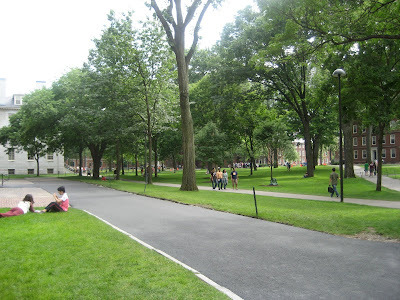Harvard University campus
A Happy fourth of July from Harvard University! During my term at Harvard so far, I have had the opportunity to dine three times a day in the magnificent building pictured below. What appears to be a giant cathedral is actually home to Annenberg Hall, Harvard's main dining facility. What most universities would consider a most prized architectural feat has been transformed by Harvard from a "spare parts" civil war memorial building into one of the most heavily used buildings on campus. If they're using this outstanding facility as a cafeteria, just imagine what else this place holds in store!
Let me first give you a snapshot of Harvard from my stay here so far. Harvard commands an indescribable sense of awe and prestige all around campus. Through the oversized buildings and perfect, New England style campus, pretense runs thick in the air. The volume of tourists running through Harvard Yard averages 8,000 per day, while the Yard itself holds only a few academic buildings and Harvard CollegeҀs 1650 first year students. Tour groups of up 50 persons pass through the yard every half hour, and even in the summer, when there are only 6,700 students enrolled in summer school out of the school yearҀs 20,000, Harvard is a crowded place.
Being enrolled in summer school there now has revealed to me how eager high school students across the world are to enroll in by far the wealthiest, most prestigious university in the world. Out of the 1,200 or so high school students enrolled in summer term through the Secondary School Program, over one in three was drawn to Harvard from a foreign country, and almost every fellow student IҀve talked to here has set Harvard as their first choice college (not me). I hate to disappoint them, but their chances of admission are astoundingly low overall, and even lower for international students, the group for whom admission seems most in demand. For the class of 2014, Harvard College received 30,489 for an entering class of 1667 freshmen, setting HarvardҀs admit rate at a record low of 6.9%.
So what exactly draws all this attention?
To begin with, Harvard claims a lot of impressive feats: it was the first institute of higher education in the United States; it has the most alumni U.S. presidents, supreme court justices, and senators of any university; and is additionally ranked number 1 by the following widely cited rankings: Academic Ranking of World Universities, U.S. News & World Report America's Best Colleges, and the Times Higher Education review. In terms of resources, Harvard has the largest endowment of any university in the world at $25.6 billion, and the largest university library collection in the United States with over 80 libraries containing over $15 million volumes.
Understandably, the undergraduate experience these 30,000 yearly applicants are seeking is one emphasizing the university's opportunities and resources, not to mention the immeasurable value of a Harvard stamp on one's degree after it's 400 year prestigious legacy. Despite the college's top notch academic resources, these survey findings published in the Harvard Crimson denote my general impression of the undergraduate experience at Harvard:
Prevalent stereotypes about how Harvard undergraduates have less fun than their peers found empirical confirmation Tuesday, when the Boston Globe reported that Harvard students gave lower ratings to their college experience than students at other elite schools in a 2002 survey.
An internal Harvard memo analyzing data from the survey found that Harvard students rated their overall satisfaction at 3.95 on a five-point scale, compared to an average of 4.16 at the 30 other schools surveyed, the Globe reported on Tuesday. Harvard students gave lower ratings than peers to the level of interaction with faculty members and the quality of social life.
This satisfaction rating placed Harvard fifth from the bottom in the survey of the 31 colleges comprising the Consortium on Financing Higher Education (COFHE). The COFHE includes all eight Ivy League schools, other top research universities like MIT and Stanford University, and leading small liberal arts colleges like Amherst College and Williams College.Ultimately, Harvard is not necessarily the most enjoyable place to spend one's undergraduate years, but I would argue that it offers the most opportunities, exposure to top faculty, graduate level coursework, and decidedly the most talented, luminary, and ambitious entering class of any undergraduate program in the world. Harvard's academic intensity and general academic program are, of course, a given. In fact, I won't even go into the specifics of student demographics and teaching style, as I have in nearly every other review, because Harvard is one of the few schools that I truly believe has everything one could want in an undergraduate education. For example, I recently acquired a book called "Find the Perfect College for You: 82 Exceptional Schools That Fit Your Personality and Learning Style
This is very arguable, but my personal academic philosophy (and that of many top colleges) is the emphasis placed on the caliber of people around you in the college or university setting, in the sense that most students learn more during their undergraduate experience from their peers than from their coursework. This is why, for example, I take college rankings and entering class statistics as a serious indication of the quality of a college; diversity of opinion and intellectual prowess tend to come hand in hand with competitive admissions (holistically, not just based on test scores and GPA). With this in mind, Harvard is likely able to be the number one producer of Rhodes and Marshall Scholars and U.S. Presidents not because their is something magical in the water of Cambridge, MA, but because the sheer age and wealth of the institution has attracted the best and brightest minds from across the world, and that collaboration is what really produces extraordinary results.

No comments:
Post a Comment